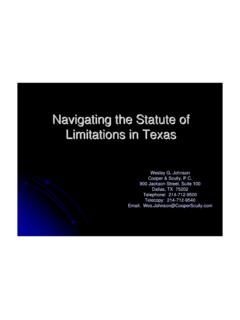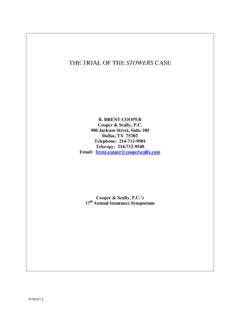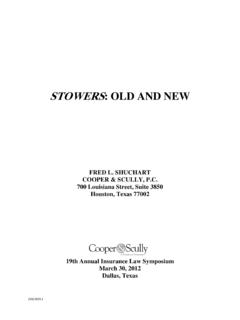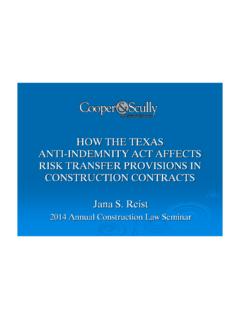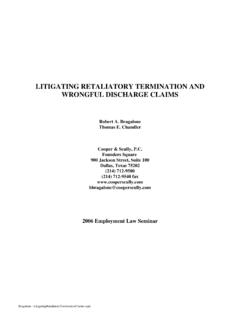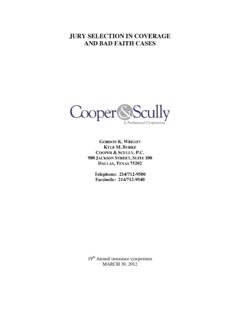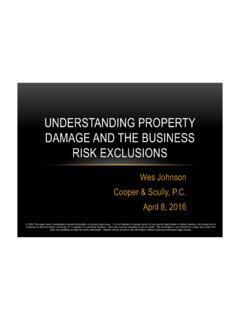Transcription of Understanding the Differences Between Premises Liability ...
1 Understanding the Differences Between Premises Liability and Negligence Kirsten A. Davenport Joanna M. Tollenaere Cooper & Scully, 900 Jackson Street, Suite 100. Dallas, TX 75202. Telephone: 214- 214-712- 712-9500. Telecopy: 214- 214-712- 712-9540. Email: First of The failure to exercise such care as an ordinarily prudent person would have exercised under the same or similar circumstances. Negligence is accidental as distinguished from intentional torts. 2. Negligence The elements of a cause of action for negligence are the following: 1. The defendant owed a legal duty to the plaintiff;. 2. The defendant breached the duty; and 3. The breach proximately caused the plaintiff's injury. 3. Understanding each 1. The defendant owed a legal duty to the plaintiff Why is the existence of a legal duty important?
2 Without a legal duty, a defendant cannot be held liable in tort. 4. 2. The defendant breached the A legal duty is breached when a defendant does not meet the required standard of care. 3. The breach proximately caused the plaintiff's injury. In other words, the plaintiff's injury could not have occurred but for the defendant's negligence. 5. Premises Liability What is Premises Liability ? Premises Liability is the body of law that sets guidelines involving the duties owed by land owners or occupiers to protect individuals who enter land from injury. It is also a form of an ordinary negligence claim that controls the manner of recovery for injuries that are sustained by an individual as a result of a CONDITION of the property, as opposed to recovering for injuries that are sustained as a result of a NEGLIGENT ACTIVITY on the The additional requirements of a Premises Liability cause of action work in the defense favor, as they make a Premises action more difficult to prove and easier to defend than an ordinary-negligence action.
3 7. Status of Invitee - is a person who enters the Premises with the possessor's express or implied knowledge and for the parties'. mutual benefit. Examples: business patrons, members of a club, tenants, employees, etc. 8. Licensee is a person who enters the property of another merely by express or implied permission 9. Trespasser is a person who enters a property of another without permission, lawful authority, right, invitation (either express or implied), and not to perform a duty for the owner/occupier, but, enters for his own purposes, convenience, pleasure, without any inducement, enticement, or implied assurance of safety from the owner. 10. Elements The elements of a cause of action for Premises Liability brought by an invitee are the following: 1. The Plaintiff was an invitee.
4 2. The defendant was a possessor of the Premises ;. 3. A condition on the Premises posed an unreasonable risk of harm;. 11. 4. The defendant knew or reasonably should have known of the danger;. 5. The defendant breached its duty of ordinary care by both (1) failing to adequately warn the plaintiff of the condition, and (2) failing to make the condition reasonably safe; and 12. 6. The defendant's breach proximately caused the plaintiff's injury. 13. Status of Defendant What is a possessor? . A defendant is a possessor if it exercises control over the Premises . 14. Keetch v. Kroger Co. Ms. Keetch was in a Kroger store buying bread. While walking toward the checkout counter, she crossed the floral department. She slipped and fell. 15. To recover on a negligent activity the person must have been injured by or as a contemporaneous result of the activity itself rather than by a condition created by the activity.
5 The main Condition of the Premises v. negligent activity 17. Premises Liability Recent Cases Del Lago Ptnrs. v. Smith, 2010 Tex. LEXIS 284 (Tex. 2010). Property owners had a duty to protect bar patron because the owners had actual and direct knowledge that a violent brawl was imminent Between drunk persons. Owners were aware of an unreasonable risk of harm at the bar that night 19. City of Waco v. Kirwan, 298 618 (Tex. 2009). City did not owe a duty to protect or warn against the dangers of natural conditions. Supreme court refused to require a landowner who posted a sign warning of a natural condition to detail each possible dangerous scenario concerning that condition. 20. Marks v. St. Luke's Episcopal Hosp., 2009 Tex. LEXIS 636 (Tex. 2009). Health care Liability claims dismissed Premises Liability claims allowed to proceed 21.
6 Dallas Homes for Jewish Aged, Inc. v. Leeds, 2010 Tex. App. LEXIS 2793 (Tex. App. Dallas Apr. 14, 2010). Nursing home resident tripped over wires in his room during the middle of the night when he got up to go to the bathroom Plaintiff not required to file an expert report because the claim was a Premises Liability claim, and not a health care Liability claim. 22. Maldonado v. Horton, Inc., 2010 Tex. App. LEXIS 2482 (Tex. App. Beaumont Apr. 8, 2010). Property owners had no Liability under Tex. Civ. Prac. & Rem. Code Ann. , (2005). because the contract did not give a right of control to the property owners 23. Leon County v. Donahoe, 2010 Tex. App. LEXIS 1006 (Tex. App. Waco Feb. 10, 2010). Evidence of the county custodian's actual knowledge sufficed to satisfy the governmental unit's actual knowledge of the alleged Premises defect.
7 24. Silas v. St. Luke's Episcopal Props. Corp., 2010 Tex. App. LEXIS 481 (Tex. App. Houston 14th Dist. Jan. 28, 2010). Plaintiff brought a negligence claim against building owner and the lessee under the doctrine of res ipsa loquitur Although the doctrine of res ipsa loquitur permits a trier of fact to base an inference of negligence on circumstantial evidence of negligence, it did not permit an inference that the defendant had actual and constructive knowledge of a condition on the Premises 25. Brooks v. PRH Invs., Inc, 303 920 (Tex. App. Texarkana 2010). Warning was adequate as a matter of law to discharge the duty to warn the customer about the possible danger. 26. Almazon v. Amli Residential Props. Ltd. P'ship, 2009 Tex. App. LEXIS 9266 (Tex. App. Austin Dec. 3, 2009). The company owed a duty to the tenant to protect her from conditions in the common area that were known or discoverable and that posed an unreasonable risk of harm.
8 Texas courts have consistently held that naturally occurring conditions, like the accumulation of ice, did not create an unreasonable risk of harm for purposes of Premises Liability . 27. Recent Premises Liability Jury Verdicts Dallas County - Slip and fall on an accumulation of ketchup on the floor. Disputed as to how long the ketchup had been on the floor and as to how it had gotten there. RESULT: Defense Verdict 29. Dallas County slip and fall in grocery store Plaintiff contended she fell after coming into contact with an unknown substance in deli area of store. RESULT: Defense Verdict 30. Plaintiff, sister of apartment tenant, claimed there was a bed bug infestation when she was living there. RESULT: Defense Verdict 31. Tarrant County slip and fall near food kiosk in mall - Infection following leg laceration Plaintiff was a business invitee at Defendant's Mall.
9 As she walked near a food kiosk, Plaintiff suffered injuries when she slipped and fell on a an accumulation of food or other waste. RESULT: Defense Verdict 32. Dallas County Slip and fall in water near entrance of grocery store - Closed head injury resulting in cognitive and ambulatory dysfunction. Plaintiff was a business invitee at Defendant's store. As she exited, Plaintiff suffered injuries when she slipped and fell on an accumulation of rainwater. RESULT: Plaintiff Verdict, $4,433, 33. Tarrant County Slip and fall in restroom of fast food restaurant - Hip fracture Plaintiff was a patron at Defendant's restaurant. As he approached the door to the restroom, Plaintiff suffered injuries when he slipped and fell on a recently mopped floor. He contended that no warnings had been posted as to the dangerous premise condition.
10 RESULT: Plaintiff Verdict, $97, 34. Dallas County slip and fall in bus terminal Plaintiff slipped and fell on tile. Plaintiff alleged negligence in failure to warn and in failure to remedy a dangerous condition. Defendant contended Plaintiff had been negligent in failure to maintain a proper lookout and failure to exercise ordinary care. RESULT: Defense verdict 35. Tarrant County slip and fall at residence of acquaintance Plaintiff did not see the three steps down to the living room and fell RESULT: Defense verdict 36. Dallas County trip and fall on uneven tile Plaintiff alleged negligence in failure to warn of and failure to remedy a dangerous condition. Defendant contended Plaintiff knew of the uneven nature of the lobby tile, having walked on it numerous times and that the incident had been due to Plaintiff's failure to exercise ordinary care.
